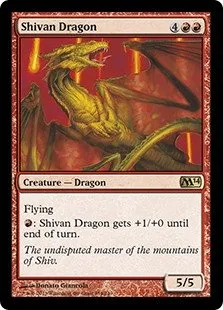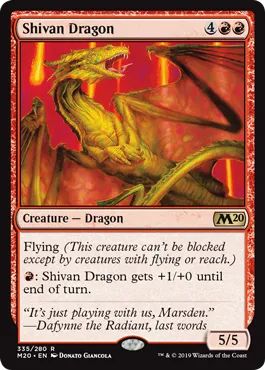Standard tournament games of Magic: The Gathering require cards from recent releases. At the time of writing, this means cards can only be from Innistrad: Crimson Vow, Innistrad: Midnight Hunt, Adventures in the Forgotten Realms, Strixhaven, Kaldheim, and Zendikar Rising. As new sets are released, old sets drop off and their cards may no longer be used.
Casual games can use cards from any set, but there are more structured options if you want to be more thematic or nostalgic. One option is to play block sets. If you really want to play with just Lorwyn/Shadowmoor themes, and have the collection to support it, this could work well.
There is also the normally illegal silver-bordered Un-sets of parody cards and joke decks. These are not intended to be used in any other games, but they make entertaining decks on their own for a less-serious game night.
There are also broader categories to consider based on three distinct generations of Magic cards.I will illustrate these with a card that has been around since the very beginning: Shivan Dragon.
Vintage
Aside from a small ban list of completely broken cards, a few cards deemed insensitive, and a few using ante mechanics or conspiracy, this allows every card ever all the way back to the beginning.
While this follows the usual rule of 60-card minimum decks and up to four copies of any spell card, there is a restricted list with only one copy allowed per deck. These restricted cards include some of the most overpowered cards ever released, the Power Nine.
If you played Magic back in the day, this could also just be a fun walk down memory lane as you play cards from Alpha through the Onslaught block and 7th Edition. A lot of the art is cheesy by modern standards, but some is quite good, and even the worst of the "bad" stuff has the charm of indie developers having fun. Do you prefer the white border or black border cards? Both were printed during this era, with core sets in white and new cards in black starting in the Unlimited block.
Modern
Wizards of the Coast redesigned the layout of the card face with the release of 8th Edition, and the Modern format only allows cards from then on. During the Modern era, Wizards phased out the use of white-bordered cards around the release of 10th Edition.
There is still a list of banned cards, but nothing is restricted to one per deck. If it isn't banned, you're free to use up to four.
I didn't start playing until this was what a "normal" card looked like, so this is how I see the cards in an abstract sense. The text is easier to read, the sections of the card are better defined, and the art style in general had improved in overall quality and detail by this point in my opinion. A lot of that may be related to improved printing and digital art technology.
Pioneer
The Return to Ravnica set included a more subtle redesign of the basic card face, and the Pioneer format includes all cards from that set to the present as I write this post. Changes included smaller borders, a holofoil stamp, more card information along the bottom edge, and a new slightly-updated bespoke typeface. Starting with Dominaria, all non-Planeswalker Legendary cards have extra flourishes to the top of the frame as well.
There are a few banned cards in the format, but not many. That list will doubtless grow as the slection of cards does a swell. If you're new to the game, and want a casual format that doesn't expire some of your deck every few months, this might be ideal for you.
Previously on Magic Monday...
Kitchen Table Magic
An Introduction to Commander
Crimson Vow
All images sourced from the Wizards of the Coast at https://gatherer.wizards.com



